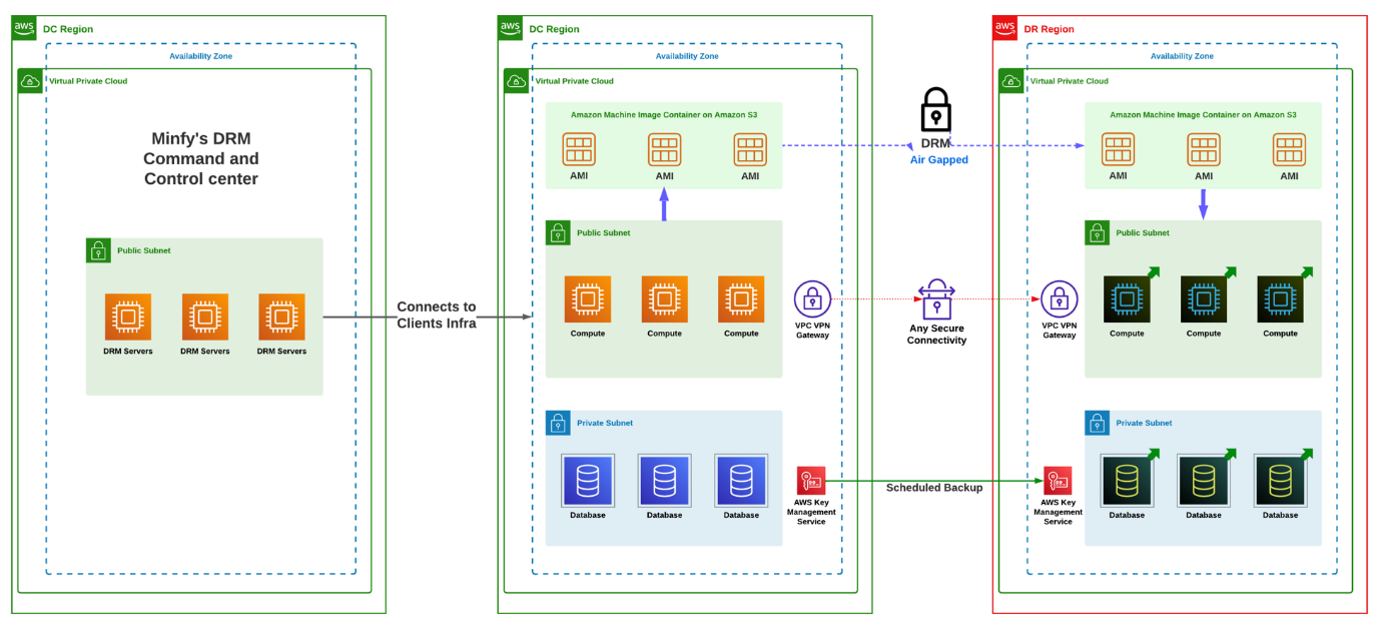- Home
- About
- Consulting
- Services
- Minfy Labs
- Industries
- Resonances
- Careers
- Contact
In today's business landscape, minimizing downtime is crucial, and companies recognize the potential for significant losses resulting from even brief disruptions. This is particularly relevant for businesses leveraging cloud infrastructure, as they can greatly benefit from a well-structured and detailed Disaster Recovery (DR) plan. Implementing a DR plan enables organizations to swiftly restore operations in the event of failures or attacks.
Traditional on-premise disaster recovery solutions can be costly and challenging to maintain. However, Amazon Web Services (AWS) offers a comprehensive solution that allows for system and network recovery, ensuring minimal data loss, distributed risk, and expedited restoration of critical applications and data
Creating an effective DR strategy necessitates a deep understanding of your infrastructure, leveraging the right AWS tools, including the expertise to facilitate fast backup and recovery processes. Minfy, a trusted MSP provider, has been supporting leading businesses in achieving minimal downtime through their tailored DR strategies.
CloudEndure Disaster Recovery is a cutting-edge Software-as-a-Service (SaaS) solution offered by Amazon Web Services (AWS). It leverages revolutionary workload mobility technology to ensure continuous replication of applications across diverse infrastructures, including physical, virtual, and cloud-based environments. This innovative solution establishes a cost-effective "staging area" that is automatically provisioned in the customer's preferred AWS Region. In the event of a disaster or for testing purposes, the solution enables the rapid deployment of up-to-date application copies, which can be fully operational within minutes. CloudEndure Disaster Recovery thus provides businesses with a robust and efficient means of safeguarding their critical applications and achieving seamless application availability in AWS.
CloudEndure Disaster Recovery is a powerful AWS Block Sync DR Tool that simplifies the implementation process. To begin, users need to install the CloudEndure Agent on their chosen source machines. The installation is seamless and doesn't require a system reboot or noticeably impact performance. Once installed, the CloudEndure Agent connects to the intuitive CloudEndure User Console, accessible via the web. From there, users can initiate an API call to the desired AWS Region, creating a designated staging area within their own account.
This staging area consists of lightweight EC2 instances functioning as Replication Servers, alongside cost-effective staging EBS volumes. This comprehensive setup enables efficient replication of data from source machines to the staging environment, facilitating robust disaster recovery capabilities.
In the CloudEndure Disaster Recovery setup, every source disk is associated with a correspondingly sized, economical EBS volume in the staging area. The main operation of Replication Servers lies in receiving data from the CloudEndure Agent, which is deployed on the source machines, and then writing it onto the staging EBS volumes. Each Replication Server can handle multiple concurrent replications from various source machines.
Once the initial replication of all source disks is completed, the CloudEndure Agent continues its tracking and replication of any subsequent changes made to the source disks, ensuring up-to-date data in the staging area.
CloudEndure Disaster Recovery offers robust data replication capabilities by utilizing continuous, asynchronous, block-level replication. This technology allows for the replication of various applications running on supported x86-based Windows and Linux operating systems that permit agent installation.
To streamline the recovery process, customers can configure a Target Machine Blueprint through the CloudEndure Console. This blueprint specifies where each machine should launch and outlines the provisioning requirements during testing or cutover. CloudEndure Disaster Recovery ensures the protection of crucial databases like Oracle, MySQL, and SQL Server, in addition to safeguarding enterprise applications like SAP.
After a disaster is resolved, CloudEndure facilitates automated failback to the source infrastructure. By leveraging the same agent-based block-level Continuous Data Replication engine, failback to the original machines occurs swiftly, with real-time data synchronization from AWS until failback. CloudEndure's automated failback feature caters to both full and incremental restores, ensuring flexibility during the recovery process.
However, the preparation for failback varies depending on the Source and Target infrastructure. For Minfy users, the CloudEndure Failback Client is employed.
Note: To leverage the CloudEndure Failback Client for failback operations, the machine must be configured to boot in BIOS mode, supporting MBR boot. Machines configured for UEFI mode, supporting GPT boot exclusively, are not compatible with this mechanism.
AWS Elastic Disaster Recovery (AWS EDRS) is a robust solution that ensures business continuity by minimizing downtime and data loss. It enables fast and reliable recovery for on-premises and cloud-based applications. With affordable storage, minimal compute resources and point-in-time recovery, AWS DRS facilitates secure data replication to a staging area subnet within the selected AWS Region. Organizations can perform non-disruptive tests, monitor replication, and conduct recovery drills to maintain operational readiness. In the event of application recovery, AWS DRS allows for launching recovery instances within minutes, providing the option to keep applications in the cloud or initiate data replication back to the primary site. AWS DRS is a dependable solution for effective disaster recovery and resiliency.

AWS Elastic Disaster Recovery (AWS EDRS) is a robust solution that guarantees swift and dependable recovery for applications, whether they are on-premises or cloud-based and it reduces downtime and data loss. By leveraging affordable storage, minimal compute resources and point-in-time recovery, AWS EDRS enables organizations to maintain operational efficiency and data integrity.
To begin, AWS Elastic Disaster Recovery is set up on source servers, initiating secure data replication. This replication process occurs within a staging area subnet in your selected AWS Region. The staging area design optimizes costs by leveraging cost-effective storage and minimal compute resources for continuous replication. Non-disruptive tests can be performed to ensure a complete implementation.
To maintain constant readiness, the replication process is continuously monitored, and regular non-disruptive recovery and failback drills are conducted. In case of application recovery, AWS enables the quick deployment of recovery instances, leveraging the latest server state or a previous point in time, all within a matter of minutes. Once applications are running on AWS, organizations have the flexibility to choose between keeping them in the cloud or initiating data replication back to the primary site once the issue is resolved.
AWS Cloud for DR

Implement a disaster recovery plan leveraging AWS for the on-premise environment and workloads deployed on the Amazon cloud
Data Protection and Recovery
![]()
Secure your systems by backing up and recovering them in case of a disaster event.
Quick Run

Maintain a fully operational backup system in run mode by replicating real-time data from the production environment.
Ready Reserve

Operate essential services in reserve mode and activate additional services as required.
Multi-Site High Availability

Operate a complete secondary production system that is fully prepared to handle traffic whenever necessary.
Minimized Downtime

AWS disaster recovery solutions help minimize downtime by enabling swift recovery and ensuring business continuity.
Data Loss Prevention

With AWS, you can implement robust disaster recovery strategies to protect your data and prevent significant data loss.
Scalable and Flexible

AWS offers scalable and flexible disaster recovery options, allowing you to adapt and expand your recovery capabilities as your business needs evolve.
Cost-Effective

Leveraging AWS for disaster recovery can help reduce costs by eliminating the need for expensive secondary data centers and infrastructure.
Automated Replication

AWS provides automated replication capabilities, ensuring that your critical data and applications are continuously replicated to a secondary location for efficient recovery.
Rapid Recovery

AWS enables quick recovery of your applications and systems, allowing you to restore operations within minutes rather than days or weeks.
Traditionally, Disaster Recovery (DR) involved maintaining a secondary copy of all infrastructure components, such as servers, in a separate data center. In the event of a failure, the secondary copy would be activated, and traffic would be redirected to it. However, in the modern cloud environment, the focus has shifted towards High Availability (HA).
High Availability is a modern approach that emphasizes continuous operations and resilience in the cloud. It incorporates multiple systems running concurrently in separate Availability Zones (AZs), which function as different data centers. If a failure occurs, the remaining systems handle requests seamlessly without the need for immediate failover. Additionally, additional infrastructure is automatically brought online to compensate for any failures.
High Availability can be implemented at different levels within the cloud infrastructure. Two common examples include:
High Availability for the database: By leveraging Amazon RDS with the "Multi-AZ" configuration, data is continuously replicated from a primary database to a secondary database in a different AZ. In the event of a database or AZ failure, the secondary database seamlessly takes over as the primary, ensuring no data loss.
High Availability for web applications: Web applications can achieve High Availability by utilizing a Load Balancer to distribute incoming requests across multiple Amazon EC2 instances running in different AZs. If an instance or AZ fails, the Load Balancer redirects traffic to the remaining instances, while Auto Scaling automatically launches new instances to restore capacity.
Disaster Recovery: Focuses on maintaining a separate set of idle infrastructures until needed, requiring a failover process to redirect traffic in case of a failure.
High Availability: Ensures continuous operations across multiple AZs without downtime or the need for failover. Additional infrastructure is provisioned automatically to maintain service levels.
Implementing High Availability using multiple EC2 instances can be cost-effective since each instance only needs to handle a portion of the workload. This approach optimizes resource utilization while maintaining high service levels. Additionally, Virtual Private Clouds (VPCs) provide logical network configurations that can span multiple AZs, eliminating the need for multiple VPCs.
VPC Endpoints are specifically designed for facilitating secure and direct connectivity between a Virtual Private Cloud (VPC) and AWS Services. While VPC Endpoints operate seamlessly across multiple Availability Zones (AZs), they are not directly relevant to Disaster Recovery (DR) or High Availability (HA) strategies. Their primary purpose is to enhance network connectivity and improve performance when accessing AWS Services from within a VPC environment.
In the modern cloud environment, High Availability plays a critical role in ensuring continuous operations and minimizing downtime. By leveraging technologies such as multi-AZ databases and Load Balancers, businesses can achieve resilience and seamless service delivery. Implementing High Availability in the cloud optimizes resource utilization and enhances cost efficiency while providing robust infrastructure for uninterrupted operations.

Minfy, a leading provider of comprehensive cloud solutions, offers a robust Disaster Recovery (DR) strategy tailored specifically for organizations with existing AWS environments that lack proper backup and DR implementations. Leveraging the power of AWS Cloud, Minfy's DR solution ensures seamless continuity and data protection for businesses in the face of unforeseen disasters.
At the core of Minfy's Disaster Recovery strategy lies cutting-edge technology in the form of AWS Snapshot Orchestration. This advanced technology empowers organizations to create orchestrated snapshots of their critical data at regular intervals, with an impressive Recovery Point Objective (RPO) of 5 to 15 minutes. This means that even in the event of a disaster, businesses can restore their systems and data to a state that is no more than 15 minutes old, thereby minimizing potential data loss to an exceptional degree.
The Recovery Time Objective (RTO) offered by Minfy's solution is equally remarkable, ranging from 2 to 6 hours. This swift RTO ensures that organizations can quickly resume their operations and maintain productivity with minimal downtime. In critical situations, every minute counts, and Minfy's DR strategy ensures that businesses can swiftly get back on track, mitigating any adverse impact on their operations.
Minfy's DR strategy also provides the flexibility of encryption, making it an ideal choice for organizations with heightened security requirements. Organizations can opt for optional encryption of their data, ensuring an added layer of protection for their critical information. Additionally, the restoration platform offered by Minfy is built within the secure AWS ecosystem, further bolstering the security and integrity of the recovery process.
One of the standout features of Minfy's DR strategy is its comprehensive Ransomware protection. With the increasing prevalence of cyber threats, safeguarding data against ransomware attacks is of paramount importance. Minfy's solution incorporates robust security measures to protect organizations from ransomware threats, ensuring that even in the face of an attack, businesses can confidently restore their data and systems without giving in to ransom demands.
At the foundation of Minfy's Disaster Recovery strategy lies a powerful combination of state-of-the-art solutions designed to cater to diverse data environments. The first technology, Disk Block Sync or Continuous Data Protection (CDP), ensures that data changes are continuously synced to the AWS cloud, enabling an impressive Recovery Point Objective (RPO) of up to 30 minutes. This means that businesses can restore their data to a state that is no more than 30 minutes old, drastically reducing the risk of data loss in case of an unexpected disaster.
Additionally, Minfy offers VMC (VMware Cloud) Native Backup, which seamlessly integrates with VMware environments to provide comprehensive VM-level backups. This capability ensures the smooth and efficient backup of VMs directly to AWS, further enhancing data protection and flexibility for organizations.
For organizations requiring a granular level of data backup, Minfy's solution provides VM File Backup to AWS S3. With this feature, businesses can perform file-level backups of their VMs to Amazon Simple Storage Service (S3), enabling easy access and recovery of specific files, folders, or configurations.
Moreover, Minfy's Disaster Recovery strategy incorporates Point in Time Recovery (PITR) functionality, allowing organizations to recover data to specific points in time. This capability enables organizations to restore their systems to a state before data corruption or errors occurred, ensuring data integrity and accuracy.
In critical disaster scenarios, quick recovery is paramount, and Minfy's solution delivers an impressive Recovery Time Objective (RTO) ranging from 4 to 6 hours. This means that organizations can rapidly restore their operations and resume business continuity with minimal downtime, thus safeguarding their productivity and customer experience.
Security is a top priority in Minfy's Disaster Recovery strategy, and automatic encryption further enhances data protection during transit and storage. With automatic encryption, organizations can rest assured that their sensitive data remains secure, meeting stringent compliance and regulatory requirements.
Minfy's Disaster Recovery strategy offers flexible restoration options, allowing organizations to choose between AWS or On-premises restoration platforms based on their unique business needs and preferences. This versatility empowers businesses with the freedom to select the most suitable recovery environment for their specific use cases.
In this comprehensive DR solution Minfy encompasses Ransomware Protection, ensuring businesses remain shielded from the increasing threat of cyberattacks. With robust security measures in place, organizations can confidently recover their data and systems without failing to ransomware demands.
At the centre of Minfy's Disaster Recovery strategy lies a comprehensive suite of technologies designed to address the unique challenges posed by complex multicloud environments and diverse data sources. The first of these technologies, AWS Snapshot Orchestration, empowers organizations to create orchestrated snapshots of their critical data, ensuring a near-live Recovery Point Objective (RPO). This means that organizations can recover their data to a state that is as close to real-time as possible, minimizing potential data loss and preserving data integrity across multiple cloud platforms and on-premises systems.
Minfy's DR solution also leverages Disk Block Sync or Continuous Data Protection (CDP) technology, enabling continuous synchronization of data changes across various data sources. This ensures that changes made to critical data are efficiently replicated, maintaining a high level of data consistency and accuracy. With an RTO ranging from 2 to 6 hours, Minfy empowers organizations to swiftly recover and restore their operations, reducing downtime and optimizing productivity.
The flexibility offered by Minfy's Disaster Recovery strategy is exemplified by its VMC (VMware Cloud) Native Backup and VM File Backup to AWS S3 features. Organizations utilizing VMware environments can seamlessly integrate native backup capabilities to AWS, ensuring efficient and reliable VM-level backups. Additionally, businesses can perform file-level backups of their VMs directly to Amazon Simple Storage Service (S3), allowing for granular recovery options and simplified access to specific files or configurations.
To further enhance data resilience and recovery options, Minfy offers VM File Backup to Disk on Cloud via an intermediary Instance. This feature facilitates backup operations by storing VM files on a cloud-based disk with the support of an intermediary instance, streamlining data restoration processes and optimizing storage utilization.
Recognizing the importance of critical business applications such as SAP, Minfy's DR strategy incorporates SAP Native DB log sync, ensuring seamless synchronization of SAP Native Database logs for enhanced data protection and streamlined recovery.
Security is paramount in Minfy's Disaster Recovery strategy, with automatic encryption providing a secure layer of protection for data during transit and storage. Organizations can rest assured that their sensitive information remains safeguarded and compliant with industry standards and regulations.
Minfy's DR solution offers versatile restoration platforms, empowering businesses to choose between AWS, On-premises, or Other Cloud environments based on their specific recovery requirements and business preferences. This adaptability allows organizations to optimize their DR setup based on existing infrastructure and operational needs.
Lets discuss your requirements to take your business to a next level of productivity and services.
Dalmia Bharat Group
Business Continuity Cloud Solution for Dalmia Bharath Group
Minfy brings a range of deep expertise in cloud migration and infrastructure management, adhering to AWS best practices, built upon its proven experience.
SREI
Streamlining Disaster Recovery with AWS
Minfy, an AWS partner with deep expertise in cloud technology, collaborated with SREI to design and implement a phased migration approach for non-critical workloads.
Discover the inner workings of Retrieval Augmented Generation (RAG) and its pivotal role in keeping Large Language Models (LLMs) current. Unravel the mechanisms behind this innovative approach and stay ahead in the world of AI advancement.
Minfy aims to streamline healthcare delivery to boost productivity. We offer a suite of AI-powered solutions for organizations of any size — from small clinics to major hospitals. These tools automate tedious tasks, freeing up precious staff hours for direct patient care.
AWS re:Invent 2023 is right around the corner, set to take place from November 27th to December 1st in the vibrant city of Las Vegas. Read this guide to discover all that you need to know before heading for AWS re:Invent 2023 at Las Vegas.
© 2022 Minfy™. Minfy Technologies. All rights reserved. | Privacy Policy | Terms and Conditions
This website stores cookie on your computer. These cookies are used to collect information about how you interact with our website and allow us to remember you. We use this information in order to improve and customize your browsing experience and for analytics and metrics about our visitors both on this website and other media. To find out more about the cookies we use, see our Privacy Policy. If you decline, your information won’t be tracked when you visit this website. A single cookie will be used in your browser to remember your preference not to be tracked.
 Go to Swayam
Go to Swayam